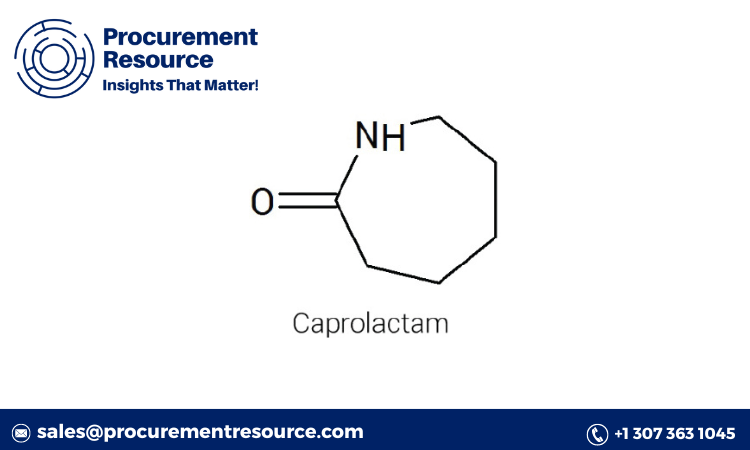Caprolactam, a crucial raw material used in the production of Nylon 6, has experienced notable fluctuations in its market price in recent years. The global demand for nylon fibers, plastics, and films, primarily in the automotive, textiles, and packaging industries, significantly impacts the pricing of caprolactam. The price trends are anticipated to follow both demand patterns and the cost of upstream materials, such as cyclohexanone and phenol, which are used to produce caprolactam.
In the forecast period from 2024 to 2032, caprolactam prices are expected to grow steadily. Several factors, such as energy costs, supply chain disruptions, and the adoption of sustainable production methods, will play critical roles in determining the caprolactam price outlook. Key industry reports suggest that price variations in the short term will be driven by global economic conditions, while long-term trends will align more with technological advancements and sustainability efforts within the chemical sector.
Outlook
The outlook for the global caprolactam market remains positive as demand for nylon-based products grows. Nylon 6’s widespread use in applications like automotive components, textiles, and industrial yarns ensures sustained demand for caprolactam. The automotive industry, particularly, has been a key driver for the caprolactam market due to the increased demand for lightweight, durable materials for fuel efficiency.
Request For Sample: https://www.procurementresource.com/resource-center/caprolactam-price-trends/pricerequest
Emerging markets in Asia-Pacific, particularly China and India, are showing robust growth in caprolactam consumption due to expanding manufacturing sectors and increasing automotive production. Meanwhile, stringent environmental regulations in Europe and North America are encouraging manufacturers to adopt cleaner production techniques, which may contribute to slight cost increases but also foster long-term market stability.
Market Dynamics
Caprolactam prices are influenced by several market dynamics:
- Raw Material Costs: Caprolactam is derived from benzene and cyclohexanone, and any fluctuations in the price of crude oil significantly impact the prices of these raw materials. A rise in oil prices typically leads to higher production costs for caprolactam.
- Supply Chain Disruptions: Global supply chain disruptions, whether caused by geopolitical issues or natural disasters, have led to intermittent price hikes. Shortages in the supply of raw materials have increased costs in the short term.
- Environmental Regulations: The caprolactam industry has faced increased regulatory scrutiny due to the environmental impact of its production process. Stricter environmental regulations could push manufacturers to adopt more sustainable methods, thereby impacting production costs and influencing price trends.
- Technological Advancements: Innovations in production technologies, such as bio-based caprolactam, have the potential to reduce production costs in the long term. Sustainable alternatives may become more prevalent, impacting the overall market pricing structure.
- Regional Demand: As demand for caprolactam products rises in Asia-Pacific due to increasing automotive and textile production, prices in this region are projected to follow an upward trend. Conversely, regions like Europe may see slower growth due to market saturation.
Demand-Supply Analysis
Caprolactam is a cyclical compound primarily used in the production of nylon 6, and as such, its demand is highly correlated with the demand for nylon-based products. The demand-supply equation is finely balanced, with several key trends impacting the supply chain:
- Supply Constraints: Caprolactam is produced through a complex chemical process, which is highly energy-intensive. Supply-side disruptions, especially in raw material procurement, can lead to price fluctuations. For example, in recent years, supply chain issues in the cyclohexanone market have directly impacted caprolactam production and pricing.
- Increasing Demand: Demand for nylon 6 and its downstream products has been rising, particularly in the automotive and textile sectors. Nylon 6 is valued for its strength, elasticity, and resistance to wear, making it a staple in manufacturing high-performance materials. This increasing demand is expected to bolster caprolactam prices in the near future.
- Technological Innovations: Recent innovations in bio-based production technologies have also shifted supply dynamics. As more sustainable methods are adopted globally, they may initially drive production costs higher, impacting the market supply and ultimately contributing to price increases.
Extensive Forecast
Over the forecast period, the caprolactam market is expected to exhibit steady growth, driven by increasing demand in the automotive, textile, and industrial sectors. The prices will largely be dictated by raw material availability and cost, particularly crude oil prices and energy consumption rates in the production process.
In the short term (2024-2026), the market may witness price volatility due to fluctuations in oil prices and economic uncertainties. However, in the long term (2027-2032), as more sustainable and efficient production methods are adopted, the prices are expected to stabilize.
Detailed Insights
The global caprolactam market has been experiencing several notable trends:
- Asia-Pacific Growth: The Asia-Pacific region is the largest consumer of caprolactam, with China leading the market due to its robust manufacturing sector. India is also emerging as a key player, driven by its growing textile industry and automotive sector.
- Sustainability Drive: Environmental concerns are driving innovation within the caprolactam industry. The push toward sustainable production methods, such as recycling nylon waste and producing bio-based caprolactam, is expected to influence prices, albeit leading to slightly higher costs in the short term.
- Technological Advancements: Advances in chemical engineering have enabled more efficient production processes, reducing waste and energy consumption. These innovations are likely to impact caprolactam pricing in the long run as manufacturers adopt more sustainable methods to meet global regulatory standards.
- Automotive Sector: The automotive industry’s ongoing shift toward lightweight materials for fuel efficiency and electric vehicles is expected to drive the demand for nylon 6, thereby increasing caprolactam consumption.
The caprolactam market is poised for steady growth in the coming years, with prices expected to rise due to increasing demand, environmental regulations, and raw material costs. As the automotive, textile, and packaging industries continue to expand, the global demand for caprolactam will remain strong. However, technological innovations and the drive toward sustainability will influence the price trends, creating a dynamic and evolving market landscape.
Contact Us:
Company Name: Procurement Resource
Contact Person: Endru Smith
Email: sales@procurementresource.com
Toll-Free Number: USA & Canada - Phone no: +1 307 363 1045 | UK - Phone no: +44 7537 132103 | Asia-Pacific (APAC) - Phone no: +91 1203185500
Address: 30 North Gould Street, Sheridan, WY 82801, USA
Website: https://www.procurementresource.com/





